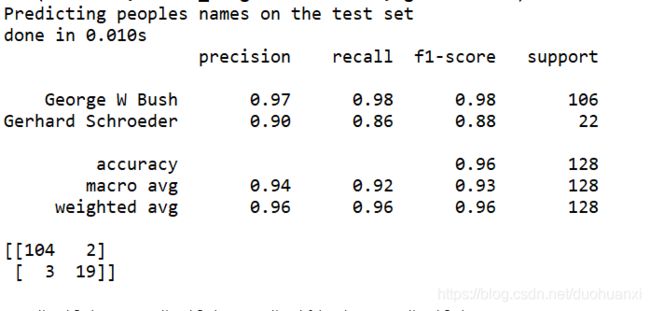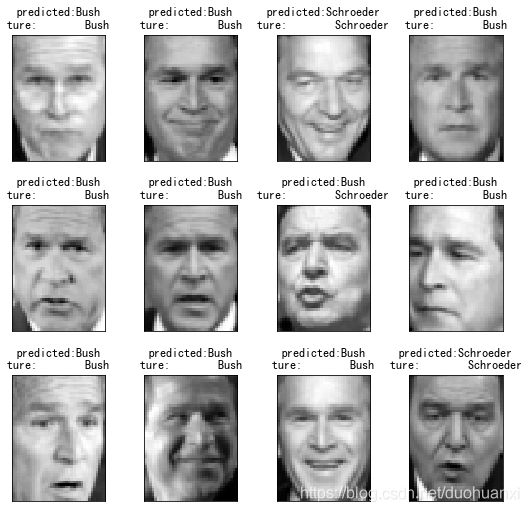深度学习基础03---支持向量机SVM人脸识别实例
这篇文章介绍一下支持向量机SVM针对线性不可分情况的应用,以人脸识别为例。
引入python相关模块
from __future__ import print_function
from time import time#计时板块
import logging#打印出进展信息板块
import matplotlib.pyplot as plt#绘图板块
from sklearn.model_selection import train_test_split
from sklearn.datasets import fetch_lfw_people
#from sklearn.grid_search import GridSearchCV
from sklearn.model_selection import GridSearchCV
from sklearn.metrics import classification_report
from sklearn.metrics import confusion_matrix
from sklearn.decomposition import PCA
#from sklearn.decomposition import RandomizedPCA
from sklearn.svm import SVC#核心库
数据集中基本信息
logging.basicConfig(level=logging.INFO,format='%(asctime)s %(message)s')#打印具体信息
lfw_people=fetch_lfw_people(min_faces_per_person=70,resize=0.4)#下载人脸数据库,类似于字典结构的对象
n_samples,h,w=lfw_people.images.shape#返回数据集实例个数,h和w
X=lfw_people.data#特征向量的矩阵
n_features=X.shape[1]#返回矩阵的列数,当shape[2]时返回行数
y=lfw_people.target#对应的人脸标记
target_names=lfw_people.target_names#返回name
n_classes=target_names.shape[0]
print('Total dataset size:')
print('n_samples:%d'%n_samples)
print('n_features:%d'%n_features)
print('n_classes:%d'%n_classes)
输出结果:

纬度达到了1850,太高了,所以后期我们需要降维
创建分类器
X_train,X_test,y_train,y_test=train_test_split(X,y,test_size=0.25)#划分训练集与测试集
n_components=150#组成元素数量,这里设定为150
print('Extracting the top %d eigenfaces from %d faces'%(n_components,X_train.shape[0]))
t0=time()#初始时间
pca=PCA(n_components=n_components,whiten=True).fit(X_train)#PCA降维
print('done in %0.3f'%(time()-t0))
engenfaces=pca.components_.reshape((n_components,h,w))#对人脸照片上提取特征值
print('Projecting the input data on the eigenfaces orthonormal basis')
#开始降维工作
t0=time()
X_train_pca=pca.transform(X_train)#转化为低纬矩阵
X_test_pca=pca.transform(X_test)
print('done in %0.3f'%(time()-t0))
print('Fitting the classifier to the training set')
to=time()
param_grid={'C':[1e3,5e3,1e4,5e4,1e5],
'gamma':[0.0001,0.0005,0.001,0.005,0.01,0.1]}#取用特征值中不同比例,构成核
clf=GridSearchCV(SVC(kernel='rbf',class_weight='balanced'),param_grid)#分类器,权重为自动
clf=clf.fit(X_train_pca,y_train)#建模
print('done in %0.3f'%(time()-t0))
print('Best estimatoc found by grid search:')
print(clf.best_estimator_)#基本信息
print('Predicting people''s names on the test set')
t0=time()
y_pred=clf.predict(X_test_pca)#预测分类
print('done in %0.3fs'%(time()-t0))
print(classification_report(y_test,y_pred,target_names=target_names))
print(confusion_matrix(y_test,y_pred,labels=range(n_classes)))#混淆矩阵,打印正确结果
定义函数打印可视化结果
#######定义函数打印可视化结果
def plot_gallery(images,titles,h,w,n_rows=3,n_col=4):
'Helper function to plot a gallery of portraits'
plt.figure(figsize=(1.8*n_col,2.4*n_rows))#建立一张图为背景
plt.subplots_adjust(bottom=0,left=0.01,right=0.99,top=0.90,hspace=0.35)
for i in range(n_rows*n_col):
plt.subplot(n_rows,n_col,i+1)
plt.imshow(images[i].reshape((h,w)),cmap=plt.cm.gray)
plt.title(titles[i],size=12)
plt.xticks(())
plt.yticks(())
#将预测与实际归类标签名字打印出来
def title(y_red,y_test,target_names,i):
pred_name=target_names[y_pred[i]].rsplit(' ',1)[-1]
true_name=target_names[y_test[i]].rsplit(' ',1)[-1]
return ('predicted:%s\nture: %s'%(pred_name,true_name))
#保存预测人名
prediction_titles=[title(y_pred,y_test,target_names,i)
for i in range(y_pred.shape[0])]#预测出的人名
plot_gallery(X_test,prediction_titles,h,w)
engenface_titles=['eigenface %d'%i for i in range(engenfaces.shape[0])]
plot_gallery(engenfaces,engenface_titles,h,w)
plt.show()
fun,预测准确率达到了96%


